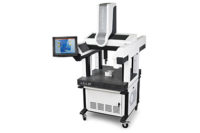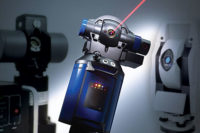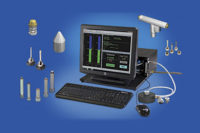Market Analysis
Cost-Effective Gages: Continue to Woo End Users
Research indicates average growth for the global gages market.

Gages Market Market Structure, Global, 2012. Source: Frost & Sullivan

Total Gages Market Percent of Revenues by Region 2012. Source: Frost & Sullivan


While most metrology markets are extremely challenged by the sluggish economy, the global gages market remains relatively well-positioned primarily due to its cost-effectiveness. Frost & Sullivan’s research indicates that the global gages market generated revenues of $172.2 million in 2012, which includes products such as height gages, plug and bore gages, ring gages and depth gages. The market is projected to reach revenues of $190.6 million in 2016, at a compound annual growth rate (CAGR) of 2.1 percent over the forecasted period.
Presence of price-sensitive end-users increase demand for global gages market
The constant demand for reduction in manufacturing and quality inspection costs has presented gages vendors with ample growth opportunities. Measurement gages range widely in prices. It depends on the gage type, material, precision/accuracy, standards governing the gages, measuring ranges, display type, and speed. Typically gages range between $40 to $1,500. Prices have steadily fallen over the last few years because of growing competition from Asian manufacturers. Gages are primarily preferred as they are priced significantly lower than more advanced systems such as coordinate measuring machines (CMMs), optical digitizers and scanners (ODS) and vision measuring machines (VMMs). Gages are the optimum solution for smaller machine shops where complex metrology systems are simply not affordable by price sensitive end users.
The need for high-precision equipment limits the growth of gages market
Gages are available at cheaper prices in the market. The growing emphasis on quality standards and stringent rules laid by International Standardization of Organization (ISO) are increasing the need for end users to opt for sophisticated machines for higher accuracy or are using low-end products due to price constraints. The need for customized inspection equipment, availability high-precision equipment such as CMM, ODS and VMM are estimated to be the primary reason bigger end users are spending on high-precision equipment.
Moreover these high-precision machines are provided with software which helps end users to capture data points of an object and analyze the measured data points for detailed analysis. These high-precision machines are far more superior in performance and provide high levels of customer satisfaction. The machine shops and metal fabrication end users industries are the key buyers of gages, in various machining operations such as cutting, welding and assembly, to quote a few. The global gages market unit shipment was approximately176,000 units in 2012. The presence of small-sized and medium-sized machine shops and metal fabrication end users are likely to remain key end users of gages products and bring in marginal growth to the gages market.
Shift towards Asia-Pacific: The growth of globalization has numerous positive impacts on the Asian market, with the Europe and U.S unable to match the cost advantages offered by the Far East. Hence, leading gage manufacturers shifted their manufacturing base to Asia.
Currently, Asia-Pacific generates 40.5 percent of revenue for the gages market. The growth of the gages market in Asia-Pacific is a more long-term; it has grown consistently at a compounded annual growth rate (CAGR) of 3.5 per cent over the past five years. This sustainable growth in Asia-Pacific is a strong reflection of the increased importance of investing in quality inspection equipment among end users. With the increased automotive, electronics, and aerospace and defense manufacturing in Asia-Pacific, growth of the gages market in Asia-Pacific is promising in the long run.
Competitive Landscape: There are more than 75 companies participating in the global gages market. The majority of these organizations are small or mid-sized companies generating revenue from their respective regional markets. However, the market is dominated by five key market participants, including Mitutoyo Corporation; Mahr GmbH; L.S. Starrett; Hexagon Metrology, Inc.; and Fred V. Fowler Company, Inc. These companies captured approximately 76.0 percent of the total market in 2012, and have captured a key market leadership role over a period.
These market participants have customized solutions, a global presence, marketing resources, direct sales, and distribution channels to establish their dominance that affects the growth of smaller participants. The presence of leading companies poses as barriers to entry, particularly in a mature market.
The Tier 2 companies include companies such as ST Industries, Inc.; Edmund Gages; Vermont Gage; Gagemaker, Inc; Glastonbury Southern Gage; Leitech; and Trimos-Sylvac SA. These Tier 2 companies rely considerably on distribution channels. A direct presence is high risk in terms of heavy capital expenditure. With no solid technical advancement in products and low market growth rates in recent years, Tier 2 market participants rely solely on indirect sales for expanding their international presence. As the indirect sales business model doesn’t require huge capital for expansion, Tier 2 companies are likely to continue building indirect sales partners across the globe.
There are several Chinese companies such as INSIZE Co., Ltd.; DongGuan Jaten Precision Instrument Co., Ltd. Jingjiang Measuring Tools Co., Ltd; Guilin Guanglu Measuring Instrument Co., Ltd; These Chinese gage manufacturers have a strong foothold in the regional market. Chinese gages manufacturers are exploring opportunities to sell equipment on various e-commerce websites. Presence in E-commerce websites is likely to bring in export business opportunities for Chinese gage manufacturers and it is unlikely to generate huge revenues.
In the following years, dominance of leading gages manufacturers will strongly impact the Tier 2 market participants. In the following years, leading gages manufacturers are likely to absorb the small companies in order to increase their market share regionally.
Conclusion
The market is likely to grow at a CAGR of 2.1 percent until 2016. The lack of technological advancements and competition from the advanced technologies such as CMM, ODS and VMM are primary factors behind prospects of low growth of the global gages market. However, on the positive side, development in the Asia-Pacific region is likely to drive moderate growth in the following years.
The fierce competition among the leading companies is likely to limit growth of regional market participants. Leading companies have direct and regional presence in all key markets using distribution channel partners which challenges the growth of regional market participants. In the new years leading companies are likely to focus on localization to capitalize on regional market opportunities, which may result in consolidation of gages market.
Product Overview
| Product | Description | Pricing Range |
| Height Gages |
A typical height gage has a vertical column attached to a flexible unit. The arm that protrudes measures the work piece. Different types of height gages include vernier height gage, dial height gage, digital dial height gage, and electronic digital height gage. Typical accessories for a height gage include riser blocks, scribers, probes, software, and the granite surface probes. A height gage can be used in several applications ranging from a mere go/ no-go type application to mapping a complex part.
Drivers: With the features such as direct Internet connection facilities and better resolution continue to make height gauges necessary to have in leading dimensional metrology equipment portfolio.
Restraints: The height gage is incapable of measuring spherical or cylindrical objects making it less preferred compared to CMMs in such application areas.
|
$50-$500 |
| Plug and Bore Gages |
Plug gages are preferred when volumes are high and tolerances are tighter. Two kinds of gages include adjustable capacity gages and fixed size gages. Plug gages are known for its repeatability, less subject to wear and are best when used with electronic data collection system. Adjustable bore gages are preferred by end-users because of its cost.
Drivers: The go/no-go gage is essential because of the simplicity it brings in the process of inspecting if a product meets specifications.
Restraints: The check fixture grabs more application areas from the plug and bore gages because of its ability to measure far more complex components. The plug and bore gages do not provide an analysis of the product as to where the fault lies.
|
$400-$1,500 |
| Ring Gages |
Ring gages are cylindrical measuring devices used primarily for measuring size and roundness of the workpiece and as a reference point completing other measuring devices.
Drivers: Ring Gages are used for numerous applications areas such as comparative gaging and as master gages to often calibrate other gages or micrometers on the shop floor.
Restraints: Although ring gages remain important for various application areas, the absence of statistical process control data increases the need to use other metrology systems for part inspection in bigger machine shops.
|
Starting from $50 they are likely to run into the thousands of dollars depending on the size, features, and application. |
| Depth Gages |
Depth gages are preferably used to measure the depth of holes, cavities, and/or other parts. Depth gages configurations include dial depth gages, digital depth gages, depth micrometer, thread depth gages, flush pin gages, and vernier depth gages.
Drivers: The ability to customize equipment to measure any range with reliable accuracy levels drives the demand for measurement of hard-to-reach holes and steps as these application areas require a contact type of precision equipment.
Restraints: Limitation in application areas restricts growth of this product in the gages market.
|
$50-$500 |
Looking for a reprint of this article?
From high-res PDFs to custom plaques, order your copy today!







